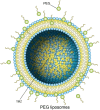Temozolomide Efficacy and Metabolism: The Implicit Relevance of Nanoscale Delivery Systems
- PMID: 35684445
- PMCID: PMC9181940
- DOI: 10.3390/molecules27113507
Temozolomide Efficacy and Metabolism: The Implicit Relevance of Nanoscale Delivery Systems
Abstract
The most common primary malignant brain tumors in adults are gliomas. Glioblastoma is the most prevalent and aggressive tumor subtype of glioma. Current standards for the treatment of glioblastoma include a combination of surgical, radiation, and drug therapy methods. The drug therapy currently includes temozolomide (TMZ), an alkylating agent, and bevacizumab, a recombinant monoclonal IgG1 antibody that selectively binds to and inhibits the biological activity of vascular endothelial growth factor. Supplementation of glioblastoma radiation therapy with TMZ increased patient survival from 12.1 to 14.6 months. The specificity of TMZ effect on brain tumors is largely determined by special aspects of its pharmacokinetics. TMZ is an orally bioavailable prodrug, which is well absorbed from the gastrointestinal tract and is converted to its active alkylating metabolite 5-(3-methyl triazen-1-yl)imidazole-4-carbozamide (MTIC) spontaneously in physiological condition that does not require hepatic involvement. MTIC produced in the plasma is not able to cross the BBB and is formed locally in the brain. A promising way to increase the effectiveness of TMZ chemotherapy for glioblastoma is to prevent its hydrolysis in peripheral tissues and thereby increase the drug concentration in the brain that nanoscale delivery systems can provide. The review discusses possible ways to increase the efficacy of TMZ using nanocarriers.
Keywords: MTIC; drug delivery systems; glioblastoma; nanocarriers; nanoparticles (NP); temozolomide (TMZ).
Conflict of interest statement
The authors declare no conflict of interest.
Figures
References
-
- Ostrom Q.T., Cioffi G., Gittleman H., Patil N., Waite K., Kruchko C., Barnholtz-Sloan J.S. CBTRUS Statistical Report: Primary Brain and Other Central Nervous System Tumors Diagnosed in the United States in 2012–2016. Neuro-Oncol. 2019;21((Suppl. 5)):v1–v100. doi: 10.1093/neuonc/noz150. - DOI - PMC - PubMed
-
- Pichaivel M., Anbumani G., Theivendren P., Gopal M. An Overview of Brain Tumor. IntechOpen; London, UK: 2022.
Publication types
MeSH terms
Substances
LinkOut - more resources
Full Text Sources
Medical
Miscellaneous




